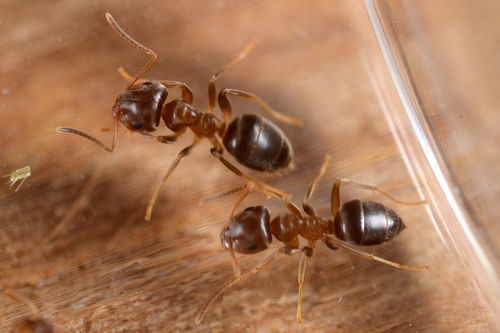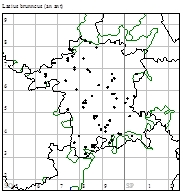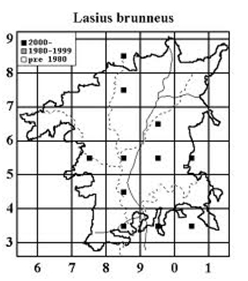Lasius brunneus (Latreille, 1798). The Tree Ant, Nationally Notable (Na) at Hurcott, Kidderminster
John Bingham & Denise Bingham
In the Worcestershire Record Harry Green (1998) provided a note on the distribution of Lasius brunneus in Worcestershire drawing attention to a paper by Alexander and Taylor (1998) on the Severn Valley as a stronghold for the species. The Thames Valley was the main stronghold for the species until the 1960s when it was reported from the Severn Vale in Gloucestershire and south Worcestershire. Shropshire had one record from Dudmaston Park in 1996. Parkland sites such as Croome Park and Hanbury Park appear to be the typical habitat in Worcestershire. Harry considered that it seemed likely that the species has been under-recorded rather than showing a recent extension of range. More records are now known but the ant is probably still under- recorded.
On 21st April 2014 Denise and I were recording our local patch at Hurcott, Kidderminster when Denise swept up a number of ants from a patch of flowering White Deadnettle Lamium album at grid reference SO848776. I identified the ants as Lasius brunneus but to confirm this I sent an image to Harry and Geoff Trevis, who both who agreed (01). The area around Hurcott has a number of large oak trees in the fields and hedgerows and the land is managed as low intensity horse pasture. Whilst not parkland it has some similarities, so it is perhaps not that surprising that L. brunneus was found here. Why it was swept off L. album is not clear, perhaps an early nectar source or were tiny aphids present on the plant? Searching the large oak trees nearby a few days later failed to reveal any ants, but they do remain well hidden in crevices so perhaps this was to be expected. The hedgerow had many old dead and dying bushes and old wooden fence rails, all possible habitat for ants. I did eventually find the ant in low numbers on a sycamore tree about 0.4 km away to the north at SO847779.
As worker ants are fugitive and rarely seen on the host tree surface perhaps sweeping any flowering plants of L. album in early spring might be a way of providing records of this elusive ant, especially if large oak trees are present nearby. As yet we have yet to see the ant on the nearest old oak to the Hurcott L. album site, but the tree has deep crevices!
Acknowledgements
Thanks to Harry and Geoff for the identification.
References
Green, H. 1998. The brown ant: Lasius brunneus (Latreille). Worcestershire Record 4:12.
Alexander KNA & Taylor A. 1998. The Severn Vale, a national stronghold for Lasius brunneus (Latreille) (Hymenoptera: Formicidae). British Journal for Entomology & Natural History 10:217-219.
Editors note.
Since 1998 Lasius brunneus has been found in many places across Worcestershire almost always on tree trunks in parkland, orchards and elsewhere. Special studies of old orchards for other species have almost always detected Lasius brunneus. I (Harry Green) have swept it off flowering Ramsons Alium ursinum on two occasions in May, once on hawthorn flowers Crataegus monogyna in May and also amongst leaf litter beneath trees on one occasion. These visits to plants other than trees are rarely reported and not understood.
Geoff Trevis is producing a Worcestershire Atlas of Aculeate Hymenoptera which should be printed in 2015. His comments together with a distribution map (02) on Lasius brunneus appear below: compare with the map from the 1998 paper (03).
Lasius brunneus (Latreille, 1798).
Formicidae: Formicinae
Has a curious distribution with two separate populations, one based around the Thames valley and extending north into East Anglia and south into the North Downs and the other in the Severn Valley up to Shropshire. In these areas it is common and not threatened.
Habitat: Generally nests in mature, living trees but has been found in stumps, hedgerows and timber framed buildings.
Flight Period: Queens and males fly in June or early July.
Worcestershire Records: The species is widely distributed across the county with 92 widely distributed records. Nationally this remains a rare species.
Images
01. Lasius brunneus at Hurcott. John Bingham.
02. Lasius brunneus distribution map 2014
03. Lasius brunneus distribution map 1998


